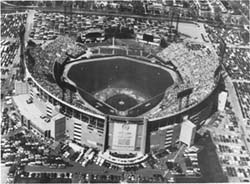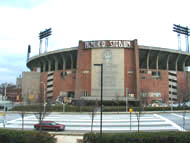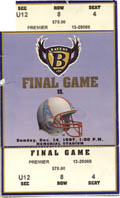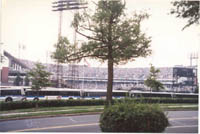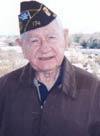| Maryland Newsline |
| Home Page |
Politics
|
| Fond Farewells to a Beloved
Baltimore Landmark
Maryland Newsline Tuesday, May 15, 2001 BALTIMORE - The memories pour out with bittersweet smiles when you talk to some Baltimoreans about Memorial Stadium, which is being reduced to a pile of rubble. “Her time just came, as much as I hate to say it,” says John Ziemann, community outreach coordinator for the Babe Ruth Birthplace and Museum in Baltimore. He spent 15 years broadcasting Orioles baseball from the stadium for WMAR television.
By September, the facade will be the only part of the stadium left standing. A wrecking ball is destroying the rest to make way for Stadium Place, a retirement community being built by the nonprofit Govans Ecumenical Development Corp. and Presbyterian Home Inc. Ziemann says demolishing the stadium is the right thing to do, but he can’t forget the games, like the last Ravens home game in 1997.
“The game ended, and they had the former Baltimore Colts come out on the field. They also had the Colts band come out on the field for the last time,” says Ziemann, who was a member of the band, now called the Ravens Marching Band. “They [re-enacted] a play, the last play of the Baltimore Colts. It was a handoff to Lenny Moore. Then Lenny Moore jogged around the stadium holding the ball up in the air with one of the younger Ravens players. Then the Colts band played the Colts fight song for the last time. After everyone left the field, the only thing still on the field was the Colts band. It was [fitting], because the Colts band was the first band on the field for the Sept. 7, 1947" game, when the Colts took on the Brooklyn Dodgers. Children like to wax sentimental, too. Natasha Palmer, 7, who only has to cross the street to get to the stadium from her home, calls it, “the greatest stadium in the whole wide world.”
The stadium also holds a special place in the heart of one notable Baltimorean. “The memories that I have of course are of Johnny Unitas, Lenny Moore, other great ball players that saved the National Football League,” says Maryland Comptroller William Donald Schaefer, a former governor and Baltimore mayor. He adds he remembers the stadium before it was a stadium--when it had sand, gravel and earth behind the seats, wooden seats full of splinters. "I have memories of great games, like when the Orioles won the championship.” “We won three [championships],” says Ziemann, who says the first one in 1966 sticks out for him because, “The Dodgers were supposed to cream us. We beat them in four games.” Ziemann also points out proudly that the stadium was the site of six World Series, one Major League baseball All-Star Game and one National Football Championship game. And it was the home field of a Super Bowl champion. Great players crossed through the doors of the stadium: Orioles Cal Ripkin Jr., and Brooks Robinson; football players Arthur Donovan and Gino Marchetti, to name a few. “In 1972, Johnny Unitas’ last game as a Baltimore Colt, we knew he was going to leave, and he was benched,” recalls Ziemann. "Then, the quarterback got hurt in the third quarter, and Unitas had to go in. And just then a plane came overhead holding a sign with ‘Unitas We Stand.’ The crowd went wild. I never heard a stadium roar like that in my life.” How did the play turn out? “He scored a touchdown to Eddie Hinton,” recalls Ziemann. There would also be visiting legends like baseball player Mickey Mantle, football players Joe Namath and Terry Bradshaw. But despite those unforgettable sports moments, for many Baltimoreans, the fact that the stadium is a memorial to veterans makes its demolition harder to take. As the stadium was being rebuilt in the 1940s, there was talk of naming it after baseball great Babe Ruth, a Baltimore native. But the Gold Star Mothers of Baltimore, who had lost sons in World War II, joined together and won the battle to name it Memorial Stadium. It’s a tribute Jim Clifford, 87, a World War II veteran and past commander of the Kelly Legion Post, takes seriously. He says the legion post held its first meeting in the locker room of the stadium back in 1946.
“I just feel close to the big thing,” says Clifford. “It is a memorial. You don’t tear down memorials.” The main thing that worries Clifford since losing the fight is losing the façade--also dedicated to World War II vets. But in a deal worked out between Preservation Maryland, GEDCO and Baltimore City, the façade will be saved. And the executive director of GEDCO, Julia Pierson, says the memory of the stadium will live on through Stadium Place. “We always said we would have some sort of memorial here,” says Pierson. “We are keeping the oval shape of the stadium to evoke the feel" of the it--building around the old structure. Baltimoreans will also be able to view parts of the stadium, since the city has been salvaging pieces of it for the Babe Ruth museum archive. Items preserved include the whole Orioles dugout, chairs, signs and railings. And many fans will only have to walk into their living rooms to remember the stadium. In September, the city held a two-day auction and sale, giving fans an opportunity to take home, among other things, seats, chairs and other parts of the stadium. The auction and sale benefited the Babe Ruth museum and helped fund the stadium's demolition. “It’s just sad,” says Schaefer, of the demolition. “You know one time, Unitas got hit on the field. They sewed him up on the field, and he went back on. Can you imagine a ball player doing that now? They would have seven doctors standing by.”
Copyright © 2001 University of Maryland College of Journalism. Text and limited photos available, with permission and credit, for use by Capital News Service clients.
| ||||||||||

